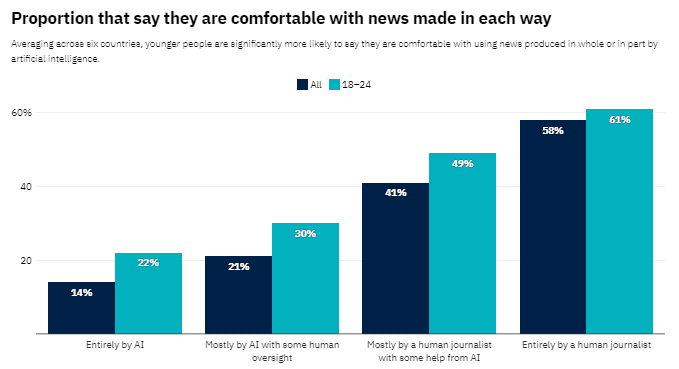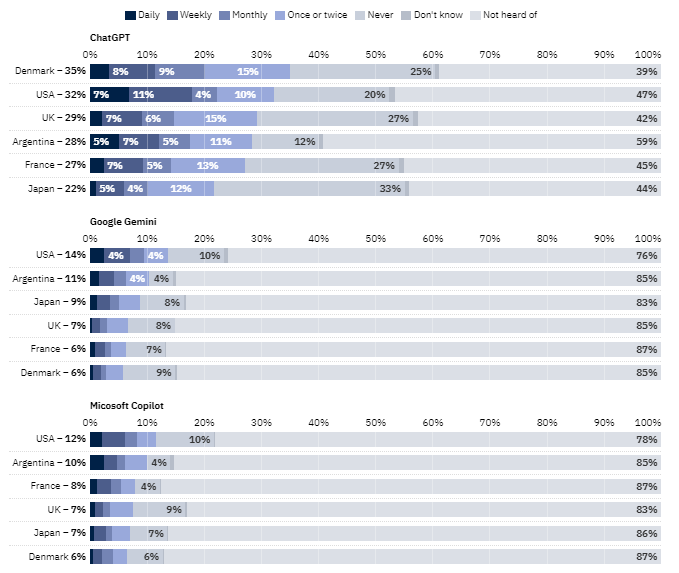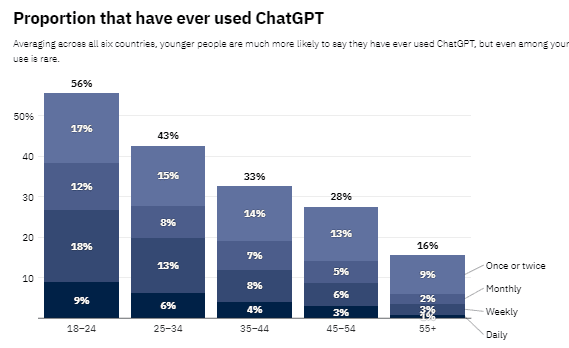

Did you know that nearly 60% of people in six major countries feel mixed about AI in the news? A groundbreaking study by the Reuters Institute for the Study of Journalism has shown us how people around the world feel about AI and machine learning in journalism. These findings show how AI is changing what people think and how news is shared globally.
The study looked at people in the UK, the US, Germany, Japan, South Korea, and Brazil. We aim to highlight key points from this research. This includes how much people know about AI in journalism, what they expect from it, and how they use it. We will also look at what people think AI should be used for in news and their worries about its effects.
The study looks into how people see AI in journalism. We want to learn about public views on AI in the media. By exploring AI’s effect on media, we aim to find out what people think and feel about new AI trends.

Reuturs conducted the study in six countries to get a wide range of opinions. We used surveys, interviews, and focus groups to collect data. This mix of methods helped us understand how AI affects media from different angles.
Their study had two main goals. First, we wanted to see how much people know about AI in journalism. Second, we looked at what people expect and think about future AI trends in news. These goals help us see how AI might change news media in the future.
In recent years, journalism has changed a lot with generative AI. How people see AI and its role in news is key to understanding this change. Even though journalists use AI more, many people don’t know much about it.
Generative AI has changed how journalists work, making news creation, analysis, and sharing easier. But, the public doesn’t know much about this tech yet. People often think of AI as just chatbots and virtual assistants, not its deeper uses in journalism.
Reuters did a survey to see how much people know about generative AI in journalism. Theywanted to find out if they know what ‘generative AI’ means and if they see AI-generated news often.
| Demographic | Awareness of Generative AI | Encounter with AI-Generated News |
|---|---|---|
| 18-24 years | High | Frequent |
| 25-34 years | Moderate | Occasional |
| 35-44 years | Low | Rare |
| 45+ years | Very Low | Very Rare |
Younger people are more likely to know about and use AI-generated content. This shows a gap in how different ages see AI. Older people know less about AI in journalism.
It’s important for news outlets to understand how the public sees AI. We need to close the gap between how journalists use AI and what the public knows. Teaching people about generative AI can help make it clearer and more familiar.
Artificial intelligence is getting better, and people are excited about its effects on news and society. Our research looks into what changes AI might bring to news and how people will use it.
AI is changing journalism by making how we get, write, and share news. An AI development company is key in this change. They help news teams use smart algorithms for better reporting. We expect to see:
AI’s use is also set to change society a lot. The AI application development process is key to these changes. It makes work easier and helps create new tools that make life better.
We expect to see:
These big changes show why we need to keep investing in AI. Working together, an AI development company and different industries will help bring these benefits to life.
In recent years, journalists have started using artificial intelligence more often. They use AI tools to make their work faster and more efficient. One key area is data analysis. AI helps journalists quickly go through lots of data, find trends, and spot important insights that would take a long time to find by hand.
AI is also used for creating content. Automated writing tools, powered by AI, can make news articles, summaries, and social media posts. This lets journalists spend more time on deeper, investigative work. It speeds up news production and helps cover more events.
AI is vital in fact-checking too. It checks data from different sources quickly, keeping news accurate and trustworthy. This makes AI a key part of ensuring news is reliable.
AI is changing how newsrooms work. It helps tailor content to what readers like and how they like to read it. This makes readers more engaged and helps news organisations know their audience better.
| Application | Description | Impact |
|---|---|---|
| Data Analysis | AI tools analyse large datasets to uncover trends and insights. | Enhanced efficiency and accuracy |
| Content Creation | Automated writing tools generate articles and social media posts. | Increased productivity and comprehensive coverage |
| Fact-Checking | Real-time cross-referencing of data from multiple sources. | Improved accuracy and credibility |
| Personalisation | AI curates content based on reader preferences and habits. | Better user engagement and audience understanding |
Generative AI is changing the media world. As AI gets better, it will play an even bigger role in newsrooms. This will bring new chances for innovation and improving how journalists work.
Global AI in journalism sparks a wide range of views. Different places show varying levels of excitement and worry. Our study looks into these varied views, focusing on where they come from.
In the UK, people have mixed feelings about AI in news. They see its potential to make things more efficient and accurate. But, they worry about the ethical sides of it. There’s a careful hope about how it will affect jobs and bias in journalism.
In the US, the view on AI in journalism is mostly positive. People see it as a way to improve news quality. Yet, they’re concerned about fake news and keeping personal data safe. This shows the need for strong rules to make sure AI reporting is right.
Europe has a varied take on AI in news. In countries like Germany and France, there’s a big focus on ethics and trustworthy AI news. Europeans want AI algorithms to be clear and strict rules to keep trust.
In Asia, especially in Japan and South Korea, AI in journalism is widely accepted. But, there are worries about losing human jobs. Many in this area see AI as a tool to help, not replace, journalists.
In Latin America and Africa, opinions on AI in news are mixed. They see its benefits, like helping in places with less resources. But, they stress the importance of approaches that fit local cultures and needs. This ensures AI journalism is for everyone and truly represents all voices.
| Region | Positive Aspects | Concerns |
|---|---|---|
| United Kingdom | Efficiency, accuracy | Bias, job security |
| United States | Quality enhancement | Misinformation, privacy |
| Europe | Ethical practices, trustworthiness | Algorithm transparency |
| Asia | High acceptance in tech-forward nations | Job displacement |
| Other Regions | Enhanced reporting in resource-limited settings | Localised approaches |

Experts share deep insights and bold predictions about AI’s future. They talk about everything from new tech to custom AI development services. This helps us understand how AI will change journalism.
“One of the most exciting trends we observe is the convergence of AI with real-time data analytics, enabling journalists to access and interpret large datasets rapidly,” states Dr. Fei-Fei Li, an influential figure in AI research. “This empowers news outlets to break stories more efficiently and accurately.”
Experts also talk about the need for ethical AI use. Professor Stuart Russell says, “As AI becomes more integral to news production, it’s critical to establish robust frameworks that safeguard against bias and ensure accountability.”
They point out areas where AI will change journalism:
The rise of custom AI development services gives news organisations a chance to innovate. By using tailored AI solutions, they can stay ahead and meet their audience’s needs.
Using AI in newsrooms brings many challenges, mainly technical and ethical. Our study shows the problems journalists face with AI.
Journalists struggle with AI tech challenges like making AI tools work. AI algorithms can be hard to use with current newsroom tech, causing problems and delays. Keeping AI systems up to date is also a big task.
Ethical issues are big problems with AI in journalism. There are worries about the accuracy and bias of automated news. Making sure AI news is trustworthy requires constant checking to prevent wrong information. Journalists must use technology wisely to keep the public’s trust.
The rise of bespoke AI development services in newsrooms has brought big benefits. These services offer unique advantages for the industry. Custom AI tools can tackle the special challenges journalists face, making their work more efficient.
This boosts the quality of news and the journalistic process. With AI technology advancing fast, many newsrooms are working with AI service providers. They’re creating solutions that fit their needs.
One key opportunity is using AI marketing solutions. These help target content better, so news reaches the right people. AI-driven marketing strategies improve engagement with readers, leading to higher satisfaction and more subscriptions.
Working with AI service providers in journalism is another chance for growth. Newsrooms can develop AI tools with their help. These tools improve content creation and data analysis.
This partnership ensures the technology meets journalists’ needs. It makes sure the tools are useful and relevant.

Here’s a look at general AI tools versus custom AI development services. Custom solutions have clear advantages:
| Criteria | Off-The-Shelf AI Tools | Custom AI Development Services |
|---|---|---|
| Flexibility | Limited to pre-defined features | Fully adaptable to specific newsroom needs |
| Cost | Generally lower initial cost | Higher initial investment with long-term savings |
| Implementation Time | Faster deployment | Requires development phase |
| User Support | Standard customer service | Dedicated support tailored to the solution |
| Performance | Might not cover all specific needs | Optimised for maximum performance |
Working with AI service providers for bespoke solutions can change the game for newsrooms. By using tailored AI marketing, newsrooms can improve efficiency, engage with readers better, and enhance content quality. In today’s fast-changing tech world, such chances are crucial for news agencies looking to the future.
In today’s changing media world, AI-enhanced marketing is changing how news is shared. These AI tools use complex algorithms to look at lots of data. This lets media groups send news that fits what people like best. Thanks to AI in media distribution, people get news that really interests them, making them more engaged.
AI has made targeting news much better and more efficient. It helps us find the right people to share news with at the best time. This means we connect with people more effectively, using less resources.
Here’s how AI in media distribution compares to old ways:
| Traditional Methods | AI-enhanced Methods |
|---|---|
| Generic content delivery | Personalised content feeds |
| Limited audience targeting | Advanced precision targeting |
| Manual distribution processes | Automated and optimised dissemination |
By using AI, media groups stay ahead and make news better for everyone. AI-enhanced marketing tools are key for modern, efficient news sharing.
In the fast-changing world of AI, it’s key to know how to make strong AI apps for journalism. These apps go through many steps to meet news organisations’ needs and boost how people interact with AI.
The process has several important phases:
Getting feedback from important people is key to making AI work well in journalism. It helps us make AI that’s not just good at what it does, but also meets the needs of journalists and readers.
Let’s look at why stakeholder feedback matters:
| Stakeholder | Role in AI Development | Impact on AI Solutions |
|---|---|---|
| Journalists | Give real insights and feedback on usability | Makes sure the AI is easy for users |
| News Organisations | Point out what the business needs and how it works | Helps the AI meet the company’s goals |
| End Users | Share what they think and expect | Makes the AI better for everyone using it |
| Developers | Put technical solutions into action and improve designs | Makes the AI work better and faster |
In conclusion, making AI apps for news is complex and needs a careful approach. It involves many steps and feedback from stakeholders. This way, we create AI tools that are not just advanced but also useful and easy to use.
Our look at the top AI companies in journalism highlights the leaders pushing innovation. They create advanced tools and shape news reporting’s future. Here are profiles of some top companies in the field.
| Company Name | Specialty | Notable Contributions |
|---|---|---|
| OpenAI | Generative AI | Creators of the renowned language model, GPT-3, widely used in newsrooms to automate content creation and enhance reporting efficiency. |
| Google AI | Natural Language Processing | Developers of BERT, a model improving the quality of news search results, ensuring readers receive precise and contextually relevant information. |
| IBM Watson | Data Analysis and Insights | Provides AI-driven analytical tools allowing journalists to uncover deeper insights from complex data sets and generate meaningful stories. |
| Bloomberg | Financial News Automation | Leaders in leveraging AI to automate financial reporting, enabling real-time, accurate dissemination of market information. |
These companies are at the forefront as AI industry leaders. They innovate and improve journalism. Their tech makes newsrooms more efficient and helps deliver quality news to audiences.
As AI technology becomes more common in newsrooms, it’s crucial to know what the public thinks about its use. Most people have clear ideas on how journalists should use AI. They want it to be used ethically and effectively.
Journalists should follow certain rules when using AI to keep their work honest and precise. People believe AI should be used openly in journalism. They think all content made with AI should be clearly marked.
This way, readers know when they’re reading AI-made content. Journalists should also check the facts in AI-generated content. This keeps trust in journalism strong.
These rules help build trust and meet the public’s expectations. They make AI a reliable tool in journalism.
The public sees great potential in AI journalism but also has concerns. They suggest limits to prevent misuse. These limits are key to keeping AI use in newsrooms ethical.
| Restriction | Rationale |
|---|---|
| Limit AI role in sensitive reporting | Human oversight is mandatory in reporting sensitive issues to ensure emotional intelligence and ethical considerations. |
| Prevent AI bias | Enforcing strict journalistic AI guidelines to ensure AI systems do not perpetuate biases or misinformation. |
| Regulate AI transparency | Mandating that all AI-generated content be transparently presented to maintain public trust. |
Following these rules helps use AI wisely. It respects journalism’s integrity and the audience’s trust and accuracy needs. With careful AI guidelines, we can enjoy AI’s benefits while avoiding its downsides.
Our study shows a mix of views on AI’s role in journalism. People’s use and knowledge of AI in news vary a lot across six countries. This shows different levels of tech use and cultural views.
We found concerns about AI’s ethics and biases in news. But, many see AI as a chance to make news better and more personal. This is clear in places like the United States and the United Kingdom, where tech is quickly adopted.
Experts believe AI could greatly change journalism. But keeping the public’s trust in AI news is key. It’s important to focus on ethics to make sure AI helps journalism, not harm it. Using AI wisely can improve news sharing. But, it’s all about finding the right balance between new tech and honest reporting. This way, people can trust the news they get.
The study aimed to understand how people see AI’s role in journalism. It looked at what people expect from AI in news reporting.
Surveys and interviews were used to collect opinions from people in six countries. They focused on awareness, use, and expectations of AI in journalism.
Some people know about these tools, while others don’t. The study found a gap between AI use in newsrooms and public knowledge.
AI is expected to improve data analysis and make content creation faster. It could change how news is selected and consumed, affecting newsroom operations.
Journalists use AI for data analysis, creating content, and automating tasks. This helps them work more efficiently and accurately.
Views on AI in journalism differ across regions. The study showed varied opinions and concerns in the UK, US, Europe, Asia, and other areas.
Experts foresee fast-paced AI advancements. They stressed the need for ethical use, custom AI solutions, and aligning with journalistic values. They discussed current and future AI trends in news.
Journalists deal with technical and ethical hurdles. These include accuracy issues, AI algorithm biases, and keeping journalistic integrity while using AI.
Custom AI services offer tailored solutions for newsrooms. They can boost efficiency and improve content personalisation, giving news organisations an edge.
AI marketing tools can widen news reach and personalise it. This leads to better targeting and engagement with audiences, optimising news distribution.
The process includes conceptualisation, design, testing, implementation, and ongoing optimisation. Feedback from stakeholders is key to creating user-focused AI solutions.
Leading companies include start-ups and tech firms specialising in AI for journalism. They offer various services that have greatly impacted the news industry.
People think journalists should use AI responsibly. They support guidelines and restrictions for ethical use. This includes being transparent, accountable, and sticking to journalistic standards.
.